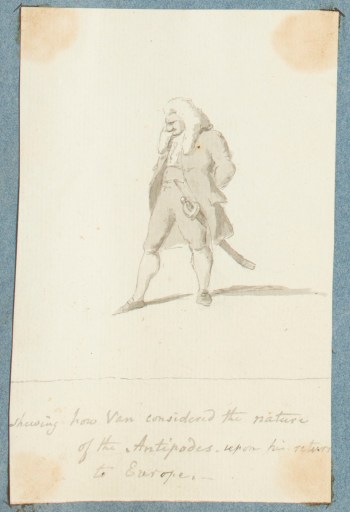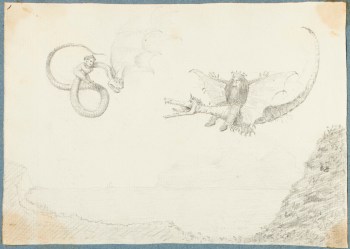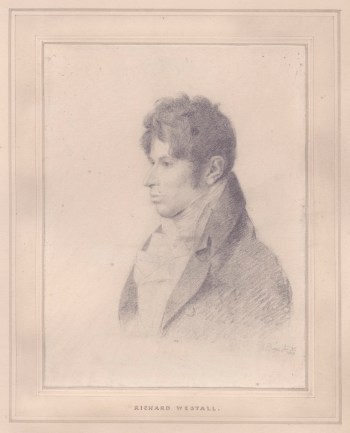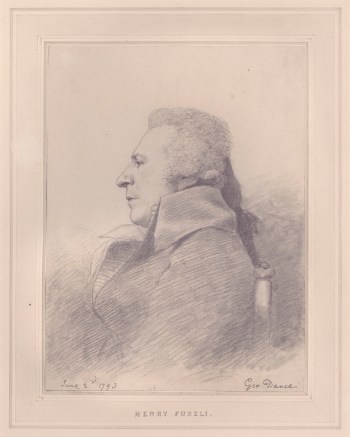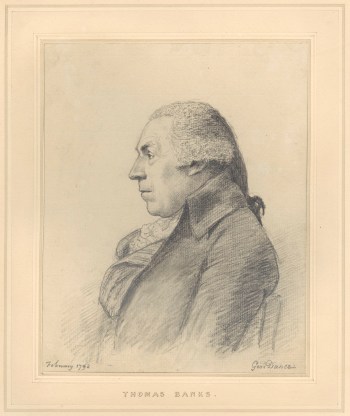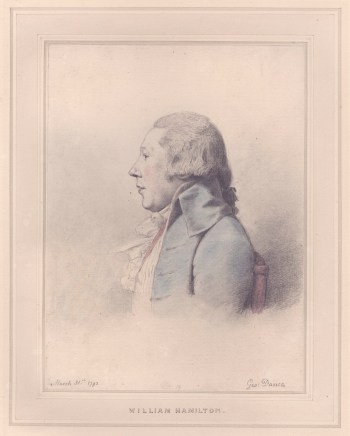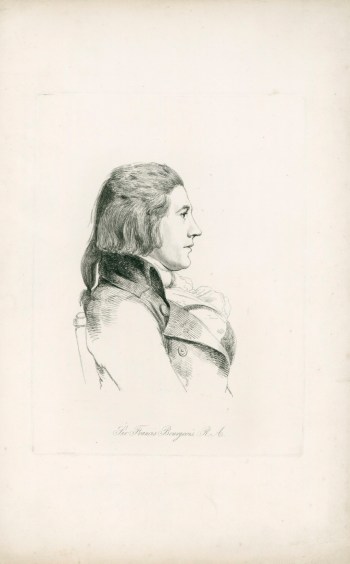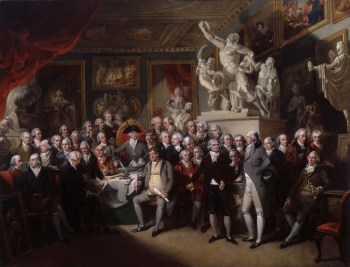George Dance RA (1741 - 1825)
RA Collection: People and Organisations
The architect George Dance the Younger was the son of George Dance the Elder (c.1694-1768), who was also an architect and is best-known for designing the Mansion House (1739-52) for the Lord Mayor of London. Alongside his brother Nathaniel, Dance the Younger spent six years in Italy studying Roman antiquity and absorbing the emerging style of neo-classicism. There he won the gold medal of the Accademia di Belle Arti, Parma, in 1763 with a design for a public gallery and, in 1764, was admitted to the Accademia di San Luca in Rome.
Dance’s father had strong connections in the City of London, as a member of the Merchant Taylors’ Company and clerk of the City works, which proved useful to his son’s early career. Soon after returning from Italy in 1765 Dance the Younger won a commission to redesign the church of All Hallows, London Wall, and, after his father’s death in 1768, he succeeded him as clerk of the City works (together they held the office from 1733-1815), and also became master of the Merchant Taylors’ Company.
Dance’s City work combined designing public buildings, and town-planning schemes. Dance’s major London building was Newgate prison (1770-84), which stood next to his Old Bailey sessions house (both were demolished in 1902). In the City of London, Dance also designed St Luke’s Hospital on Old Street, two debtors’ prisons and part of the Guildhall (including the new south façade combining Gothic and Indian styles). Few of Dance’s ambitious urban planning projects were realised, although his Finsbury Circus and St George’s Circus continue to shape the London cityscape. Dance’s City responsibilities restricted his other public commissions, but these included the Shakespeare Gallery in Pall Mall, where the publisher John Boydell exhibited the paintings of Shakespearean subjects that he commissioned from the leading artists of the day. Dance also undertook a limited amount of work designing or altering country houses, largely on behalf of London clients.
Dance was a Founder Member of the Royal Academy in 1768 where, although he seldom exhibited, he contributed much in terms of practical help and advice. In 1798 Dance succeeded Thomas Sandby as Professor of Architecture at the Academy, although he failed to deliver any lectures and resigned in 1806. Dance was a man of diverse interests and, in his spare time, he made a series of distinctive profile portraits of his fellow Academicians (now in the RA collection) which constitute a unique record of the Regency artistic establishment. A selection of these profiles was etched and published from 1809 by William Daniell.
After his death in 1825, Dance was buried in the crypt of St Paul’s Cathedral between the graves of his fellow Academicians Benjamin West PRA and Henry Fuseli RA, befitting his considerable impact on the built environment of Georgian London.
Profile
Foundation Member
Born: 1741 in London, England, United Kingdom
Died: 14 January 1825
Nationality: British
Elected RA: 10 December 1768
Professor of Architecture: 1798 - 1805
Gender: Male
Preferred media: Architecture, Illustration, and Cartooning
Works by George Dance in the RA Collection
172 results
-
![George Dance RA, One dancing and one seated figure]()
George Dance RA
One dancing and one seated figure
Pencil on cream wove paper
-
![George Dance RA, 'Squaring the Circle']()
George Dance RA
'Squaring the Circle'
Pencil on cream laid paper
-
![George Dance RA, Two men lying on chaise longues]()
George Dance RA
Two men lying on chaise longues, 1815
Pen and ink over pencil on cream laid paper
-
![George Dance RA, Two caricature faces]()
George Dance RA
Two caricature faces
Pencil and black chalk on cream laid paper
-
![George Dance RA, Woman seated at a table]()
George Dance RA
Woman seated at a table
Pencil on cream wove paper
-
![George Dance RA, A running woman and a seated figure]()
George Dance RA
A running woman and a seated figure
Pen and ink on cream laid paper
-
![George Dance RA, Head and shoulders of a man]()
George Dance RA
Head and shoulders of a man
Pencil on cream laid paper
-
![George Dance RA, Imaginary hybrid creature]()
George Dance RA
Imaginary hybrid creature
Black chalk on cream laid paper
-
![George Dance RA, Three praying figures]()
George Dance RA
Three praying figures
Pen and ink on cream laid paper
-
![George Dance RA, Two couples]()
George Dance RA
Two couples
Pen and ink on cream laid paper
-
![George Dance RA, Sketches of four figures]()
George Dance RA
Sketches of four figures
Pen and ink over pencil on cream laid paper
-
![George Dance RA, Two men seated at a table]()
George Dance RA
Two men seated at a table
Pen and ink over pencil on cream laid paper
-
![George Dance RA, Sketch of a figure on horseback and a caricature of a man in profile]()
George Dance RA
Sketch of a figure on horseback and a caricature of a man in profile
Pen and ink over pencil on cream laid paper
-
![George Dance RA, Woman seated at a table]()
George Dance RA
Woman seated at a table
Pencil on cream laid paper
-
![George Dance RA, Profile portrait of a man]()
George Dance RA
Profile portrait of a man
Pencil on cream laid paper
-
![George Dance RA, Imaginary creature]()
George Dance RA
Imaginary creature
Black chalk on cream laid paper
-
![George Dance RA, Imaginary creature]()
George Dance RA
Imaginary creature
Black chalk on cream laid paper
-
![George Dance RA, Mr and Mrs Pepper quarrelling]()
George Dance RA
Mr and Mrs Pepper quarrelling
Pencil on cream laid paper
-
![George Dance RA, Caricature of a male figure]()
George Dance RA
Caricature of a male figure
Pencil on cream laid paper
-
![George Dance RA, Two women and a man walking]()
George Dance RA
Two women and a man walking
Pen and ink on cream laid paper
-
![George Dance RA, A woman taking snuff]()
George Dance RA
A woman taking snuff
Pen and ink over pencil on cream wove paper
-
![George Dance RA, A woman and a man in military uniform]()
George Dance RA
A woman and a man in military uniform
Pencil on cream laid paper
-
![George Dance RA, 'Very Queer People']()
George Dance RA
'Very Queer People'
Pencil with pen and ink on cream wove paper
-
![George Dance RA, 'Studies of Drawing']()
George Dance RA
'Studies of Drawing'
Pen and ink on laid paper
-
![George Dance RA, Imaginary creatures]()
George Dance RA
Imaginary creatures
Pencil on cream laid paper
-
![George Dance RA, Man in contemporary dress]()
George Dance RA
Man in contemporary dress
Pencil, pen and ink and watercolour on cream wove paper
-
![George Dance RA, Four caricatures]()
George Dance RA
Four caricatures
Pen and ink on cream laid paper
-
![George Dance RA, A Foreign Grandee & a great likeness]()
George Dance RA
A Foreign Grandee & a great likeness
Pen and ink over pencil on cream wove paper
-
![George Dance RA, To all appearance a very sound nap]()
George Dance RA
To all appearance a very sound nap
Pencil on cream laid paper
-
![George Dance RA, Figure hiding from two ghostly apparitions]()
George Dance RA
Figure hiding from two ghostly apparitions
Pen and ink with pencil on cream laid paper
-
![George Dance RA, A ghost appearing to two frightened figures]()
George Dance RA
A ghost appearing to two frightened figures
Pencil on cream laid paper
-
![George Dance RA, A ghost appearing to a group of figures]()
George Dance RA
A ghost appearing to a group of figures
Pen and ink and watercolour with gouache (?) on laid paper
-
![George Dance RA, The Ghost of Belerophon]()
George Dance RA
The Ghost of Belerophon
Pen and ink with pencil on cream laid paper
-
![George Dance RA, A ghost appearing to a man in bed]()
George Dance RA
A ghost appearing to a man in bed
Pencil, pen and ink, and watercolour on laid paper
-
![George Dance RA, Van Diemen's Portrait]()
George Dance RA
Van Diemen's Portrait
Pen and ink and wash on cream laid paper
-
![George Dance RA, The death of Van Diemen]()
George Dance RA
The death of Van Diemen
Pen and ink on cream laid paper
-
![George Dance RA, Showing how Van considered the nature of the Antipodes]()
George Dance RA
Showing how Van considered the nature of the Antipodes
Pen and ink and wash on cream laid paper
-
![George Dance RA, An account of this lost in the Fire of London]()
George Dance RA
An account of this lost in the Fire of London
Pen and ink and wash on cream laid paper
-
![George Dance RA, Van dreamt of having taken a dose of physic in Van Diemen's Land]()
George Dance RA
Van dreamt of having taken a dose of physic in Van Diemen's Land
Pen and ink and wash on cream laid paper
-
![George Dance RA, Second visit to Van Diemen's Land]()
George Dance RA
Second visit to Van Diemen's Land
Pen and ink and wash on cream laid paper
-
![George Dance RA, Is shipwreck'd on Van Diemen's Land]()
George Dance RA
Is shipwreck'd on Van Diemen's Land
Pen and ink and wash on cream laid paper
-
![George Dance RA, He falls desperate in love]()
George Dance RA
He falls desperate in love
Pen and ink on cream laid paper
-
![George Dance RA, His early assiduous study of Navigation]()
George Dance RA
His early assiduous study of Navigation
Pen and ink on cream laid paper
-
![George Dance RA, Birth of Van Diemen]()
George Dance RA
Birth of Van Diemen
Pen and ink on cream laid paper
-
![George Dance RA, Fetch the midwife]()
George Dance RA
Fetch the midwife
Pen and ink and wash on cream laid paper
-
![George Dance RA, A skeleton and two figures in a Gothic building]()
George Dance RA
A skeleton and two figures in a Gothic building
Pen and ink with wash on wove paper
-
![George Dance RA, Amazement!]()
George Dance RA
Amazement!
Pen and ink on cream laid paper
-
![George Dance RA, Scene with a skeleton appearing to a figure in bed]()
George Dance RA
Scene with a skeleton appearing to a figure in bed
Watercolour with pen and ink on cream laid paper
-
![George Dance RA, Caricatures of two male figures]()
George Dance RA
Caricatures of two male figures
Pen and ink over pencil on cream laid paper
-
![George Dance RA, What a pretty creature!]()
George Dance RA
What a pretty creature!
Pencil on thick wove paper
-
![George Dance RA, You see plainly she don't like you]()
George Dance RA
You see plainly she don't like you
Pencil on cream laid paper
-
![George Dance RA, Ah will ye! Then I'll maul ye both!]()
George Dance RA
Ah will ye! Then I'll maul ye both!
Pencil on cream wove paper
-
![George Dance RA, O dear! I've lost my wig!]()
George Dance RA
O dear! I've lost my wig!
Pencil on cream wove paper
-
![George Dance RA, She little thinks he hears her last appeal]()
George Dance RA
She little thinks he hears her last appeal
Pencil on cream laid paper
-
![George Dance RA, An idea of two Philosophers squaring the circle]()
George Dance RA
An idea of two Philosophers squaring the circle
Pencil on cream laid paper
-
![George Dance RA, A Pair of Snuffers]()
George Dance RA
A Pair of Snuffers
Pencil on cream wove paper
-
![George Dance RA, Bajezet]()
George Dance RA
Bajezet
Pencil on cream laid paper
-
![George Dance RA, Can't say I know them, being masked]()
George Dance RA
Can't say I know them, being masked
Pencil on cream laid paper
-
![George Dance RA, This dear confession enraptures me!!!]()
George Dance RA
This dear confession enraptures me!!!
Pen and wash over pencil on cream laid paper
-
![George Dance RA, A woman handing a letter to another woman]()
George Dance RA
A woman handing a letter to another woman
Watercolour over pencil on cream laid paper
-
![George Dance RA, I think my stomach begins to Ach!]()
George Dance RA
I think my stomach begins to Ach!
Pencil on cream laid paper
-
![George Dance RA, Sam Groneman Dunghill Contractor]()
George Dance RA
Sam Groneman Dunghill Contractor
Pencil on cream wove paper
-
![George Dance RA, The Quietus]()
George Dance RA
The Quietus
Pencil on cream wove paper
-
![George Dance RA, Madam I'm quite surprised!]()
George Dance RA
Madam I'm quite surprised!
Pencil on cream laid paper
-
![George Dance RA, Graceful attitudes]()
George Dance RA
Graceful attitudes
Pen and wash with watercolour on cream laid paper
-
![George Dance RA, A Snug Pot]()
George Dance RA
A Snug Pot
Pen and ink with watercolour on cream wove (?) paper
-
![George Dance RA, A Scorpionical horned Offingoffle saluting a Billantail of high Quality]()
George Dance RA
A Scorpionical horned Offingoffle saluting a Billantail of high Quality
Pencil on cream laid paper
-
![George Dance RA, Howcommumariums with their trusty steed]()
George Dance RA
Howcommumariums with their trusty steed
Pencil on cream laid paper
-
![George Dance RA, Refined sentimentalists]()
George Dance RA
Refined sentimentalists
Pen and ink and wash on cream laid paper
-
![George Dance RA, He's just going to bite me!]()
George Dance RA
He's just going to bite me!
Pencil on cream wove paper
-
![George Dance RA, Happy Pair! None but the brave &c.]()
George Dance RA
Happy Pair! None but the brave &c.
Pen and ink with wash on cream laid paper
-
![George Dance RA, There's Fun!]()
George Dance RA
There's Fun!
Pencil on cream wove paper
-
![George Dance RA, Quiet rumination on recent events]()
George Dance RA
Quiet rumination on recent events
Pen and ink on cream laid paper
-
![George Dance RA, Sir, I listen to your energetick relation with pleasure]()
George Dance RA
Sir, I listen to your energetick relation with pleasure
Pencil on cream laid paper
-
![George Dance RA, An Antidiluvian Old Cloathsman]()
George Dance RA
An Antidiluvian Old Cloathsman
Pen and ink with wash on cream laid paper
-
![George Dance RA, Pray don't get up or he'll knock you down again!]()
George Dance RA
Pray don't get up or he'll knock you down again!
Pencil on cream laid paper
-
![George Dance RA, Figure with outstretched arms]()
George Dance RA
Figure with outstretched arms
Pencil on cream laid paper
-
![George Dance RA, A woman with two suitors]()
George Dance RA
A woman with two suitors
Pencil on cream laid paper
-
![George Dance RA, Two male figures]()
George Dance RA
Two male figures
Pen and ink on cream laid paper
-
![George Dance RA, I'm very dry & the churl won't give me a drop!]()
George Dance RA
I'm very dry & the churl won't give me a drop!
Pencil on cream laid paper
-
![George Dance RA, The President of the Junta of Salamanca]()
George Dance RA
The President of the Junta of Salamanca
Pen and ink with wash on cream laid paper
-
![George Dance RA, Scene in a bedroom interior]()
George Dance RA
Scene in a bedroom interior
Pencil on cream laid paper
-
![George Dance RA, Poo Poo it can't be]()
George Dance RA
Poo Poo it can't be
Pencil on cream wove paper
-
![George Dance RA, Woman reading by candlelight]()
George Dance RA
Woman reading by candlelight
Black chalk over pencil on cream wove paper
-
![George Dance RA, Figure in the entrance of a cave]()
George Dance RA
Figure in the entrance of a cave
Pencil on cream laid paper
-
![George Dance RA, A man carrying a spear, probably Macbeth]()
George Dance RA
A man carrying a spear, probably Macbeth
Pen and ink over pencil on cream laid paper
-
![George Dance RA, I'm rather alarmed!]()
George Dance RA
I'm rather alarmed!
Pencil on laid paper
-
![George Dance RA, Profile of a man with exaggerated features]()
George Dance RA
Profile of a man with exaggerated features
Pencil on cream laid paper
-
![George Dance RA, Head of a ghostly figure]()
George Dance RA
Head of a ghostly figure
Pencil on cream laid paper
-
![George Dance RA, Sorrow, Despair and Grief]()
George Dance RA
Sorrow, Despair and Grief
Pencil on laid paper
-
![George Dance RA, A man holding a club in a landscape]()
George Dance RA
A man holding a club in a landscape
Pencil on cream wove paper
-
![George Dance RA, Charles XII of Sweden]()
George Dance RA
Charles XII of Sweden
Pencil on wove paper (recto painted)
-
![George Dance RA, A Pair of Giant's Ghosts]()
George Dance RA
A Pair of Giant's Ghosts
Pencil on cream wove paper
-
![George Dance RA, Scene in a bedroom interior]()
George Dance RA
Scene in a bedroom interior
Pencil on cream laid paper
-
![George Dance RA, Acrobats on horseback]()
George Dance RA
Acrobats on horseback
Pencil on cream laid paper
-
![George Dance RA, A man dancing, probably Auguste Vestris]()
George Dance RA
A man dancing, probably Auguste Vestris
Pen and ink over pencil on cream wove paper
-
![George Dance RA, A figure on horseback]()
George Dance RA
A figure on horseback
Cream laid paper
-
![George Dance RA, They don't seem to approve of her]()
George Dance RA
They don't seem to approve of her
Pen and ink on cream laid paper
-
![George Dance RA, Both Cosey]()
George Dance RA
Both Cosey
Pencil on cream laid paper
-
![George Dance RA, Welcome home dear Brother!]()
George Dance RA
Welcome home dear Brother!
Pen and ink over pencil on cream laid paper
-
![George Dance RA, Sketch of an imaginary creature and a skeleton playing musical instruments]()
George Dance RA
Sketch of an imaginary creature and a skeleton playing musical instruments
Pen and ink on cream laid paper
-
![George Dance RA, The Man in the Moon practicing]()
George Dance RA
The Man in the Moon practicing
Pen and ink over pencil on cream laid paper
-
![George Dance RA, Dancing figures wearing pointed hats]()
George Dance RA
Dancing figures wearing pointed hats
Pen and ink over pencil on cream laid paper
-
![George Dance RA, A profile portrait of a man]()
George Dance RA
A profile portrait of a man
Pencil and chalk on cream laid paper
-
![George Dance RA, Head and shoulders portrait study of a man]()
George Dance RA
Head and shoulders portrait study of a man
Pencil on cream laid paper
-
![George Dance RA, Profiles of a man and two women]()
George Dance RA
Profiles of a man and two women
Pencil and black chalk on cream laid paper
-
![George Dance RA, Three men standing on a dome with two trumpeters beneath]()
George Dance RA
Three men standing on a dome with two trumpeters beneath
Pen and ink with pencil on cream laid paper
-
![George Dance RA, It's impossible to say exactly , what they are talking about]()
George Dance RA
It's impossible to say exactly , what they are talking about
Pen and ink with wash over pencil on cream wove paper
-
![George Dance RA, A cool conference growing warmish]()
George Dance RA
A cool conference growing warmish, December 9th 1814
Pen and ink over pencil on cream wove paper
-
![George Dance RA, Castle ramparts and three figures]()
George Dance RA
Castle ramparts and three figures
Pencil and black chalk on cream wove paper
-
![George Dance RA, A child pulling the wig of a sleeping man]()
George Dance RA
A child pulling the wig of a sleeping man
Pencil on cream laid paper
-
![George Dance RA, A male dancer and a goose]()
George Dance RA
A male dancer and a goose
Pencil and watercolour on cream wove paper
-
![George Dance RA, Four imaginary creatures]()
George Dance RA
Four imaginary creatures
Pencil on cream laid paper
-
![George Dance RA, Crowned man on a dragon with a flying genii holding a torch]()
George Dance RA
Crowned man on a dragon with a flying genii holding a torch
Pencil on cream wove paper
-
![George Dance RA, Repose & Exertion]()
George Dance RA
Repose & Exertion
Pen and ink over pencil on cream laid paper
-
![George Dance RA, Male figure wearing a cloak and loin cloth]()
George Dance RA
Male figure wearing a cloak and loin cloth
Pencil on cream laid paper
-
![George Dance RA, Imaginary figure with no torso]()
George Dance RA
Imaginary figure with no torso
Pencil on cream laid paper (with wash?)
-
![George Dance RA, Monster with horns and webbed feet]()
George Dance RA
Monster with horns and webbed feet
Pencil on cream laid paper
-
![George Dance RA, Crowned man riding a dragon and a man clinging to a flying serpent]()
George Dance RA
Crowned man riding a dragon and a man clinging to a flying serpent
Pencil on cream laid paper
-
![George Dance RA, Portrait of Henry Tresham, R.A.]()
George Dance RA
Portrait of Henry Tresham, R.A., 10 March 1793
Pencil on cream wove paper
-
![George Dance RA, Portrait of Thomas Daniell, R.A.]()
George Dance RA
Portrait of Thomas Daniell, R.A.
Pencil on cream wove paper
-
![George Dance RA, Portrait of Edmund Garvey, R.A.]()
George Dance RA
Portrait of Edmund Garvey, R.A., 10 November 1793
Pencil and pink chalk on cream wove paper
-
![George Dance RA, Portrait of Jeremiah Meyer, R.A.]()
George Dance RA
Portrait of Jeremiah Meyer, R.A., by 1789
Pencil on light grey laid paper
-
![George Dance RA, Portrait of George Michael Moser, R.A.]()
George Dance RA
Portrait of George Michael Moser, R.A.
Pencil on off-white laid paper
-
![George Dance RA, Portrait of Paul Sandby, R.A.]()
George Dance RA
Portrait of Paul Sandby, R.A., 21 December 1794
Pencil, black and pink chalk on cream wove paper
-
![George Dance RA, Portrait of Joseph Nollekens, R.A.]()
George Dance RA
Portrait of Joseph Nollekens, R.A., 17 February 1810
Pencil on cream wove paper
-
![George Dance RA, Portrait of Robert Smirke, R.A.]()
George Dance RA
Portrait of Robert Smirke, R.A., 29 March 1793
Pencil, black and white chalk on cream wove paper
-
![George Dance RA, Portrait of Robert Smirke jnr., R.A.]()
George Dance RA
Portrait of Robert Smirke jnr., R.A., 31 July 1809
Pencil on cream wove paper
-
![George Dance RA, Portrait of Richard Westall, R.A.]()
George Dance RA
Portrait of Richard Westall, R.A., 31 January 1803
Pencil on cream wove paper
-
![George Dance RA, Portrait of Charles Rossi, R.A.]()
George Dance RA
Portrait of Charles Rossi, R.A., 3 September 1798
Pencil and pink chalk on cream wove paper
-
![George Dance RA, Portrait of Francis Milner Newton, R.A.]()
George Dance RA
Portrait of Francis Milner Newton, R.A., 5 May 1793
Pencil with pink chalk and blue and black wash on wove paper
-
![George Dance RA, Portrait of Charles Catton, R.A.]()
George Dance RA
Portrait of Charles Catton, R.A., 25 May 1793
Pencil, pink and black (?) chalk on cream laid paper
-
![George Dance RA, Portrait of John Bacon, R.A.]()
George Dance RA
Portrait of John Bacon, R.A., 13 April 1793
Pencil with pink chalk on cream wove paper
-
![George Dance RA, Portrait of John Opie, R.A.]()
George Dance RA
Portrait of John Opie, R.A., 9 March 1793
Pencil, black and pink chalk on cream wove paper
-
![George Dance RA, Portrait of Sir William Beechey, R.A.]()
George Dance RA
Portrait of Sir William Beechey, R.A., 13 December 1795
Pencil and pink chalk on cream wove paper
-
![George Dance RA, Portrait of Francis Wheatley, R.A.]()
George Dance RA
Portrait of Francis Wheatley, R.A., 17 March 1793
Pencil, pink and black chalk on cream wove paper
-
![George Dance RA, Portrait of George Stubbs, A.R.A.]()
George Dance RA
Portrait of George Stubbs, A.R.A., 8 February 1794
Pencil and black chalk on wove paper
-
![George Dance RA, Portrait of Francesco Bartolozzi, R.A.]()
George Dance RA
Portrait of Francesco Bartolozzi, R.A., 31 March 1793
Pencil with pink, blue and black chalks on cream laid paper
-
![George Dance RA, Portrait of John Russell, R.A.]()
George Dance RA
Portrait of John Russell, R.A., 13 April 1793
Pencil, black and pink chalk on cream wove paper
-
![George Dance RA, Portrait of John Singleton Copley, R.A.]()
George Dance RA
Portrait of John Singleton Copley, R.A., 30 March 1793
Pencil with black and pink chalks on cream wove paper
-
![George Dance RA, Portrait of John Francis Rigaud, R.A.]()
George Dance RA
Portrait of John Francis Rigaud, R.A., 1 April 1793
Pencil with black, pink and brown chalks on cream wove paper
-
![George Dance RA, Portrait of Johann Zoffany, R.A.]()
George Dance RA
Portrait of Johann Zoffany, R.A., 1 June 1793
Pencil, black and pink chalks, and blue wash on cream wove paper
-
![George Dance RA, Portrait of J.M.W. Turner, R.A.]()
George Dance RA
Portrait of J.M.W. Turner, R.A., 31 March 1800
Pencil and faint pink chalk on cream wove paper
-
![George Dance RA, Portrait of Henry Fuseli, R.A.]()
George Dance RA
Portrait of Henry Fuseli, R.A., 2 June 1793
Pencil and pink chalk on cream wove paper
-
![George Dance RA, Portrait of Joseph Farington, R.A.]()
George Dance RA
Portrait of Joseph Farington, R.A., 5 May 1793
Pencil, black and pink chalk, blue wash and black wash on cream wove paper
-
![George Dance RA, Portrait of Sir Francis Bourgeois, R.A.]()
George Dance RA
Portrait of Sir Francis Bourgeois, R.A., 16 March 1793
Pencil with black and pink chalk on cream wove paper
-
![George Dance RA, Portrait of William Tyler, R.A.]()
George Dance RA
Portrait of William Tyler, R.A., 17 October 1796
Pencil and pink chalk on cream wove paper
-
![George Dance RA, Portrait of John Flaxman, R.A.]()
George Dance RA
Portrait of John Flaxman, R.A., 12 November 1796
Pencil and pink chalk on cream wove paper
-
![George Dance RA, Portrait of Joseph Bonomi, A.R.A.]()
George Dance RA
Portrait of Joseph Bonomi, A.R.A., 4 August 1793
Pencil with black and pink chalks and blue wash on cream wove paper
-
![George Dance RA, Portrait of Thomas Banks, R.A.]()
George Dance RA
Portrait of Thomas Banks, R.A., February 1793
Pencil and black chalk (?) on cream laid paper
-
![George Dance RA, Portrait of Richard Cosway, R.A.]()
George Dance RA
Portrait of Richard Cosway, R.A., 6 April 1793
Pencil with black, pink and blue chalks on cream wove paper
-
![George Dance RA, Portrait of Nathaniel Marchant, R.A.]()
George Dance RA
Portrait of Nathaniel Marchant, R.A., 8 February 1794
Pencil with black and pink chalks on cream wove paper
-
![George Dance RA, Portrait of Edward Burch, R.A.]()
George Dance RA
Portrait of Edward Burch, R.A., 16 March 1793
Pencil with black and pink chalks on cream wove paper
-
![George Dance RA, Portrait of Sir William Chambers, R.A.]()
George Dance RA
Portrait of Sir William Chambers, R.A., 17 March 1793
Pencil, black and pink chalks on cream wove paper
-
![George Dance RA, Portrait of Sawrey Gilpin, R.A.]()
George Dance RA
Portrait of Sawrey Gilpin, R.A., 27 April 1798
Pencil with black and pink chalks on cream wove paper
-
![George Dance RA, Portrait of James Barry, R.A.]()
George Dance RA
Portrait of James Barry, R.A., 2 April 1793
Pencil with black and pink chalks on cream wove paper
-
![George Dance RA, Portrait of John Richards, R.A.]()
George Dance RA
Portrait of John Richards, R.A., 11 March 1793
Pencil with black and pink chalks on cream wove paper
-
![George Dance RA, Portrait of James Northcote, R.A.]()
George Dance RA
Portrait of James Northcote, R.A., 2 March 1793
Pencil with black and pink chalks on cream wove paper
-
![George Dance RA, Portrait of William Hodges, R.A.]()
George Dance RA
Portrait of William Hodges, R.A., 10 March 1793
Pencil with black and pink chalks on cream wove paper
-
![George Dance RA, Portrait of William Hamilton, R.A.]()
George Dance RA
Portrait of William Hamilton, R.A., 31 March 1793
Pencil, and chalks with wash on cream laid paper
-
![George Dance RA, Portrait of Sir Thomas Lawrence, P.R.A.]()
George Dance RA
Portrait of Sir Thomas Lawrence, P.R.A., Probably 2 February 1794
Pencil, black chalk, with pink and red chalk (?, possibly a wash) and blue wash on cream wove paper
-
![George Dance RA, Portrait of John Yenn, R.A.]()
George Dance RA
Portrait of John Yenn, R.A., 17 November 1793
Pencil and pink chalk (?) on cream wove paper
-
![George Dance RA, Portrait of Ozias Humphry, R.A.]()
George Dance RA
Portrait of Ozias Humphry, R.A., May 1793
Pencil and pink chalk (?) on cream wove paper
-
![George Dance RA, Portrait of Benjamin West, P.R.A.]()
George Dance RA
Portrait of Benjamin West, P.R.A., 3 March 1793
Pencil and pink chalk (?) on cream wove paper
-
![George Dance RA, Portrait of James Wyatt, P.R.A.]()
George Dance RA
Portrait of James Wyatt, P.R.A., 31 March 1795
Pencil and faint pink chalk on cream wove paper
-
![George Dance RA, Portrait of Joseph Wilton, R.A.]()
George Dance RA
Portrait of Joseph Wilton, R.A., 30 March 1793
Pencil, black and pink chalk (?) on cream wove paper
-
![George Dance RA, Portrait of Henry Thomson, R.A.]()
George Dance RA
Portrait of Henry Thomson, R.A., 6 January 1805
Pencil on cream laid paper
-
![George Dance RA, Portrait of Dominic Serres, R.A.]()
George Dance RA
Portrait of Dominic Serres, R.A., 11 March 1793
Pencil, black and pink chalk on cream wove paper
-
![George Dance RA, Portrait of Thomas Sandby, R.A.]()
George Dance RA
Portrait of Thomas Sandby, R.A., 24 March 1793
Pencil and pink chalk (?) on cream wove (?) paper
-
![George Dance RA, Portrait of Thomas Stothard, R.A.]()
George Dance RA
Portrait of Thomas Stothard, R.A., 15 January 1794
Pencil , black and pink chalk on cream wove paper
-
![George Dance RA, Portrait of Henry Howard R.A.]()
George Dance RA
Portrait of Henry Howard R.A., 11 August 1800
Pencil and black chalk with a pink chalk (?) on cream laid paper
-
![George Dance RA, Portrait of John Hoppner, R.A.]()
George Dance RA
Portrait of John Hoppner, R.A., 10 November 1793
Pencil, black chalk with pink chalk (?) on cream wove paper
Works after George Dance in the RA Collection
3 results
Works associated with George Dance in the RA Collection
2 results
Associated books
4 results
-
Walter Thornbury
The Life Of J.M.W. Turner, R.A. Founded On Letters And Papers Furnished By His Friends And Fellow Academicians. By Walter Thornbury. [Epigraph] In Two Volumes. Vol. I. (II.) - London:: 1862. The right of Translation is reserved.
07/1106
-
A Collection Of Portraits Sketched From The Life Since The Year 1793 By George Dance, Esq. R.A. And Engraved In Imitation Of The Original Drawings By William Daniell, A.R.A. - Vol. I. - (II.) - London: :: 1809. (- 1814.)
04/3361
-
Prince Hoare
Memoirs of Granville Sharp, Esq. : composed from his own manuscripts, and other authentic documents in the possession of his family and of the African Institution. / by Prince Hoare. With observations on Mr. Sharp's Biblical criticisms, by the Right Rev. the Lord Bishop of St. David's. - London: 1820
12/4136
-
Edwin Beresford Chancellor
The lives of the British architects from William of Wykehan to Sir William Chambers - London; New York: 1909
17/720
Associated archives
30 results
-
[draft or copy] Sir William Chambers, to George III
12 Mar 1795
Item YE/4
-
Thos. Lawrence, to Joseph Farington, West Cowes, Isle of Wight
[21 Oct 1820]
Item LAW/3/221
-
Jos. Farington, Woodvale, to Sir Thomas Lawrence, 65 Russell Square
12 Oct 1820
Item LAW/3/216
-
Sam. Lysons, King's Bench Walk, to Thos. Lawrence, rome
5 May 1819
Item LAW/3/41




































